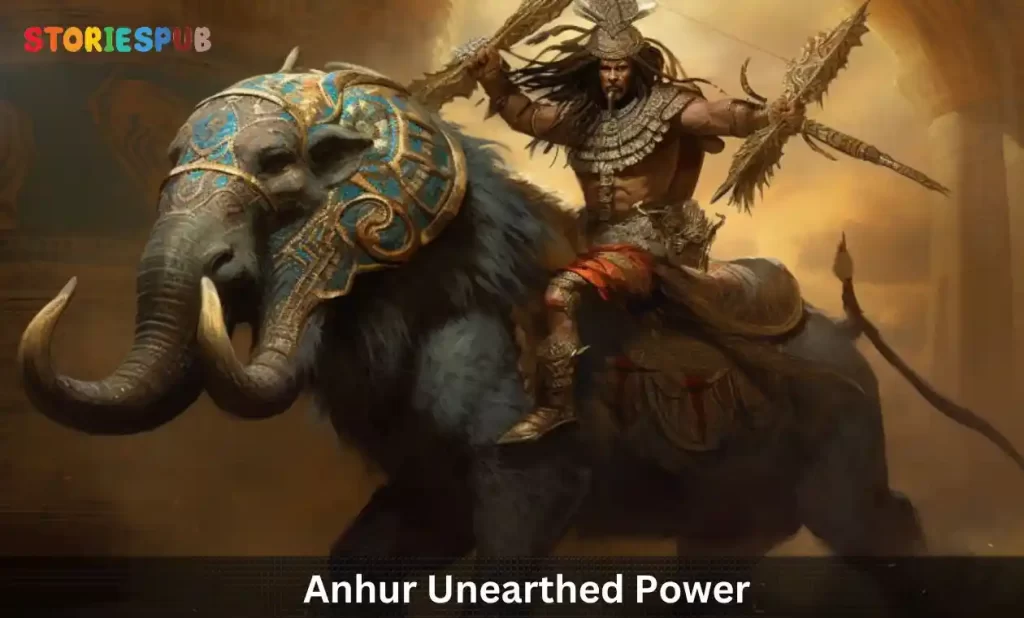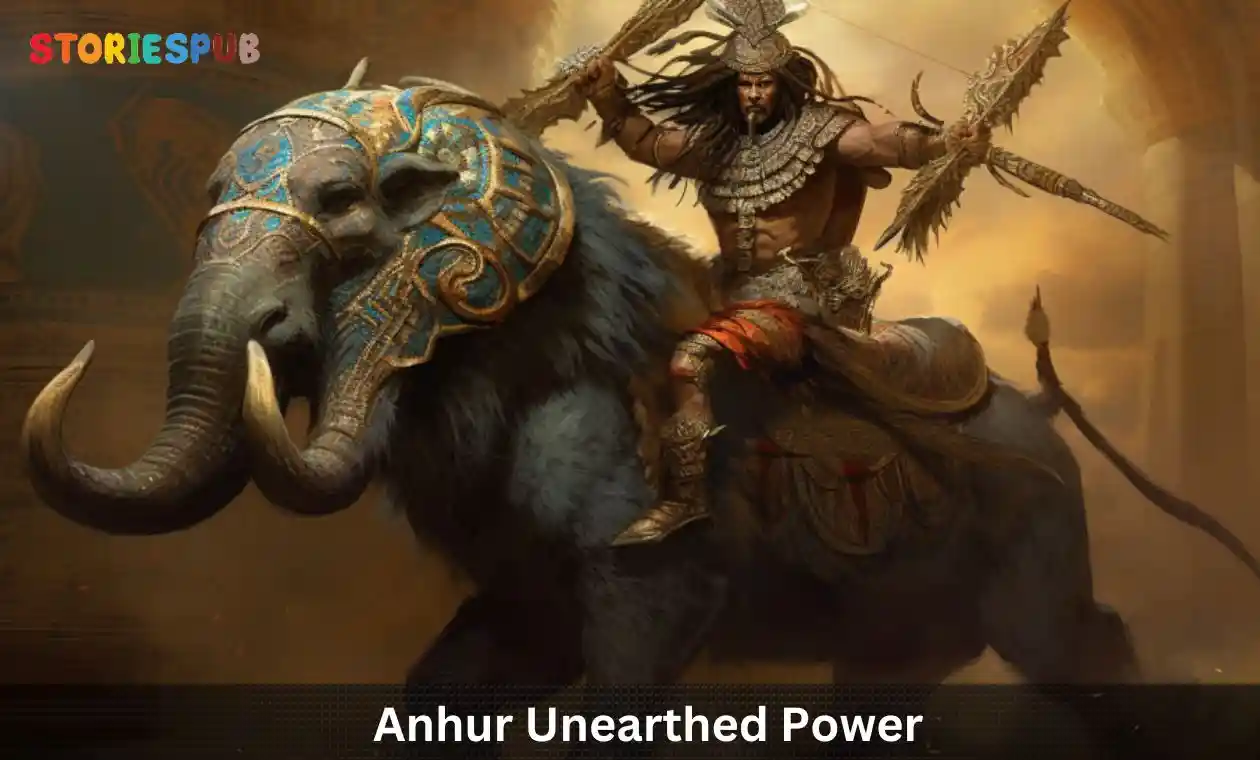Anhur: Egypt’s Mighty Warrior God Uncovered

Introduction
Egyptian mythology is one of the oldest and most fascinating mythologies in the world. It tells the stories of gods and goddesses who played important roles in the creation, maintenance, and destruction of the universe.
These deities were believed to have immense powers, which they used to control not only nature but also human destiny. They were worshipped with great reverence and devotion as people sought their blessings for abundance, protection, and prosperity.
Anhur is one of the lesser-known gods in Egyptian mythology. Despite his relative obscurity, he was an important figure in ancient Egypt, especially among warriors and hunters who revered him as a god of war and hunting.
His name means “skybearer” or “he who brings back the distant one,” which suggests his association with celestial phenomena such as sunsets and sunrises. He was also known by other names such as Onuris or An-Her, meaning “the bringer of light” or “the mighty one.”
The Importance of Gods and Goddesses
In ancient Egyptian culture, religion played a central role in people’s lives. It provided them with a framework for understanding themselves and their place in the cosmos. The gods and goddesses represented various aspects of nature, society, emotions, values, virtues that Egyptians cherished or feared.
They were believed to have both human-like qualities such as love, anger, jealousy as well as supernatural abilities like immortality or omniscience. The Egyptians built magnificent temples dedicated to their deities where they could offer prayers , sacrifices ,and offerings .
These temples served not only religious purposes but also political functions since they were often run by priests who had significant power over land ownership , business transactions among others . Pharaohs were often seen as representatives or even incarnations of gods, which legitimized their rule and enhanced their authority.
Anhur’s Introduction
Anhur was a god of many talents. He was worshipped as a god of war, hunting, and fertility. He was associated with arrows, lions, and the color red.
He was also known for his agility and strength which made him a popular choice among soldiers who sought his protection in battles. Despite his military prowess, he was also revered as a lover since he had relationships with various goddesses such as Hathor or Bastet.
Anhur’s depiction in art varies depending on the era and the region but some common elements include his wearing of a crown with two feathers on top , carrying arrows or spears , riding on lions , or holding captives in chains . His appearance also suggests that he may have been influenced by other cultures such as Nubian or Libyan since some depictions show him wearing clothing similar to theirs .
Although Anhur is not as well-known as other gods such as Ra or Osiris , he played an essential role in maintaining balance and order in the universe. His association with war ensured that Egypt remained secure from external threats while his connection to hunting guaranteed that people had enough food .
His fertility aspect helped women conceive children while his love affairs created alliances between different gods and goddesses. In the next sections, we will explore Anhur’s origin story, symbolism in depth along with discussing how he was worshipped during ancient times amongst other things that make him an important figure in Egyptian mythology despite being less famous than some of his peers.
Origin and Symbolism
Anhur is one of the lesser-known gods in Egyptian mythology, but his origin story and symbolism are fascinating. Anhur was originally known as Onuris, which means “he who brings back the distant one.” He was considered a god of war, hunting, and fertility.
According to legend, Anhur was born to Ra and his wife Hathor. He was often depicted as a muscular man with a headdress made of feathers and holding a spear or arrows.
One of the primary symbols associated with Anhur is the lion. Lions were seen as powerful creatures in ancient Egypt and were often associated with royalty.
The color red was also closely linked to Anhur’s symbolism, representing both strength and victory. Another symbol associated with Anhur is the sun.
In fact, he was often referred to as “the bringer of light” or “the shining one.” As a sun god, he represented the warmth and light that came from the sun each day. In addition to these symbols, Anhur was also known for his prowess in archery.
Arrows were seen as weapons that could bring down even the strongest foes from a distance. As such, they became symbols of strength and power.
The Origin Story of Anhur
The origin story of Anhur is tied closely to his role as a god of war. According to legend, when Ra grew tired of ruling over humanity on earth, he decided to create an army to keep order among humans.
He turned to his wife Hathor for help in finding someone worthy enough to lead this army. Hathor chose her son Anhur due to his bravery and skill in battle.
She convinced him that it was his duty as a god to protect humans from chaos and destruction. Anhur quickly rose through the ranks thanks largely in part to his skill in battle.
He became a fierce warrior who could take on even the strongest of enemies. As a result, he quickly became one of the most revered gods in all of Egypt.
The Symbolism of Anhur
The symbolism associated with Anhur is heavily rooted in Egyptian mythology and culture. One of the most prominent symbols associated with Anhur is the lion.
Lions were seen as powerful creatures in ancient Egypt and were often depicted as symbols of royalty. In addition to lions, the color red was also closely tied to Anhur’s symbolism.
The color red represented both strength and victory, which were key traits that Anhur embodied as a god of war and hunting. Another symbol closely linked to Anhur was the sun.
As mentioned earlier, he was often referred to as “the bringer of light” or “the shining one.” This association with the sun represented warmth and light, two things that were essential for life in ancient Egypt. Arrows played an important role in Anhur’s symbolism.
Arrows were seen as weapons that could bring down even the strongest foes from a distance. As such, they became symbols of strength and power – two traits that were essential for any successful warrior or hunter.
Anhur: A God with Many Meanings
While many gods in Egyptian mythology had clear-cut meanings and roles, Anhur was unique in that he embodied several different traits at once. He was a god of war, hunting, fertility, love, and more – all at once! This multifaceted nature made him a beloved figure among Egyptians who saw him as both strong and protective but also loving and nurturing when necessary.
His many roles also made him an excellent mediator between other gods who might have been at odds with each other. For example, he played an important role in bringing together Ra, Set, and other gods to defeat the evil serpent Apep.
Conclusion
Anhur is a fascinating figure in Egyptian mythology with a rich history and symbolism. From his role as a god of war and hunting to his association with lions, suns, arrows, and the color red – Anhur embodied many different meanings at once.
Despite being one of the lesser-known gods of ancient Egypt, Anhur’s legacy has continued on through art, literature, and popular culture. His multifaceted nature makes him an intriguing figure to study – one who represents both strength and love in equal measure.
Worship and Temples
Anhur was a god that was highly revered in ancient Egyptian culture. He was worshipped for his association with strength and power, particularly in the areas of war, hunting, and fertility.
As a result, he had several temples dedicated to him across different cities in Egypt. The worship of Anhur involved various ceremonies and rituals that were designed to appease the god and show devotion to him.
This included offerings of food, drink, and other valuable items such as precious metals and gems. These offerings were made at specific times during the year when Anhur was believed to be most receptive to them.
One of the most significant temples dedicated to Anhur was located in Thinis, which is now known as Girga. This temple was built during the Old Kingdom period (c. 2686 – c. 2181 BCE) and served as a center for Anhur’s worship for centuries after its construction.
The temple featured an imposing entrance gate that led into a large courtyard where priests would perform ceremonies. Another important temple dedicated to Anhur was located in This (modern-day Luxor).
This temple is believed to have been built during the Middle Kingdom period (c. 2055 – c. 1650 BCE) and served as a vital religious center for several centuries after its construction. The temple featured various statues depicting Anhur holding weapons such as arrows or spears.
Sebennytos (modern-day Samannud) also had an important temple dedicated to Anhur that featured regular festivals held in honor of the god. The festival usually consisted of processions where priests carried images of Anhur throughout the city while shouting praises to him.
Overall, these temples played an essential role in ancient Egyptian society by providing a central location for worshiping gods like Anhur who were considered vital protectors of the people. They allowed worshippers to show their devotion and offer thanks for the blessings they received from these powerful gods.
Mythology
Anhur is known as a god of war, hunting, and fertility. As such, there are many myths surrounding him that involve battles, hunting expeditions, and even romantic relationships.
One popular myth involving Anhur is his role in defeating the evil serpent Apep alongside other gods like Ra and Set. In this myth, Apep is a powerful serpent who represents chaos and disorder.
He resides in the underworld and seeks to destroy the balance of the universe by stopping the sun from rising each day. Anhur joins forces with Ra and Set to defeat Apep once and for all.
Together they use their weapons to pierce Apep’s body until he is defeated. Another myth involving Anhur centers around his relationship with the goddess Hathor.
Hathor was known as a goddess of love, beauty, joy, and motherhood. She was often depicted as a cow or a woman with cow horns on her head.
In this myth, Anhur falls deeply in love with Hathor but fears that she does not return his affections. Anhur decides to seek advice from Thoth, the god of wisdom and writing.
Thoth suggests that he should write a poem expressing his love for Hathor. Anhur takes Thoth’s advice and writes an exquisite poem that expresses his feelings for Hathor in beautiful language.
When he reads it to her, she is moved by its beauty and agrees to be his lover. Anhur also plays an important role in another well-known myth involving Horus’ eye being injured during a battle against Seth’s followers.
When Horus’ eye was injured during this battle against Seth’s followers, he sent out several gods including Anhur to find it while Seth guarded it atop of his head while playing dice games for it with Thoth at times declaring Seth had won thus keeping the Eye in his possession. Eventually Horus was able to reclaim his eye after it was restored by Thoth.
These stories reflect the multifaceted nature of Anhur as a god of war, hunting, fertility, and love. His adventures and relationships with other gods and goddesses speak to the importance of balance and harmony in Egyptian mythology.
Anhur’s Romantic Relationship
The story of Anhur’s love for Hathor is one of the most popular myths involving this lesser-known god. It speaks to Anhur’s gentle side as a god associated with fertility and love. Hathor, in turn, represents beauty and joy which are both important aspects of life in ancient Egypt.
A key part of this myth is Anhur’s decision to seek advice from Thoth before confessing his feelings to Hathor. This reflects the importance of wisdom and thoughtfulness in ancient Egypt.
Writing poetry was also an essential skill for those seeking to express their emotions through literature. When Anhur reads his poem to Hathor, she is moved by its beauty which speaks volumes about Anhur’s ability as a poet.
The fact that he was able to express himself so eloquently shows that he had a deep understanding of language and literature. This myth also highlights how love can bring balance into our lives just like how it brought balance into Anhur’s life by balancing out his warrior side with his gentle side through a romantic relationship.
The Battle Against Apep
The story of the battle against Apep is one that cements Anhur as a significant figure among other gods who fought against chaos represented by Apep who wanted nothing but destruction for everything included all living beings including humans or animals or even plants or crops on earth. Anhur played an important role in this battle because he was known for being an excellent fighter. His weapons were particularly effective against Apep because they symbolized light, fire, and the sun which represented life and order against chaos.
Anhur’s role in this myth also shows the importance of teamwork in ancient Egyptian mythology. The fact that he joined forces with Ra and Set to defeat Apep highlights the idea that nothing can be accomplished alone and that cooperation is essential for success.
This story is also a representation of how all gods irrespective of their scope of powers united to protect the universe from destruction. It shows us why Anhur was revered by ancient Egyptians who considered him as one of the most important gods in their pantheon.
Restoring Horus’ Eye
Another myth involving Anhur centers around his role in restoring Horus’ eye after it was injured during a battle against Seth’s followers. Thoth played a key role in this story as well by restoring Horus’ eye through his wisdom, knowledge, and healing abilities.
In this myth, Anhur joins other gods to help restore Horus’ eye which played an important role in maintaining balance and harmony throughout Egypt. His involvement speaks to his importance among other gods as someone who could be relied on for support during difficult times.
Overall, these myths demonstrate that Anhur was an important figure in Egyptian mythology whose power extended beyond just being a god of war or hunting or fertility. He represented balance between good and evil, light and darkness – everything that was essential for life on Earth to thrive according to ancient Egyptians.
Legacy
Carrying on through Art
Throughout Egyptian history, Anhur was a figure that was prominently depicted in art. His association with war and hunting was often depicted through his portrayal as a warrior, donning a crown of feathers, and armed with arrows or a spear.
In addition to this, he is often depicted as a lion-headed deity- another symbol of his association with war and hunting. Anhur’s depiction in ancient Egyptian art continued to influence the depictions of other gods and goddesses.
For example, Sekhmet – the goddess of healing and destruction- also has the head of a lioness which likely drew inspiration from Anhur’s portrayal. Even in modern times, more than 3000 years after ancient Egypt came to an end; Anhur continues to be an inspiration for artists who continue to depict him as a powerful god through paintings, sculptures, or other forms of art.
Literature Influence
Aside from his influence on art, Anhur is also known for inspiring literature both ancient and contemporary. There are numerous myths involving him that have been passed down through generations; most notably his role in defeating the evil serpent Apep alongside other gods like Ra and Set.
In modern literature too; authors have found inspiration from this lesser-known god. For example; author Wilbur Smith wrote “Warlock” which features an antagonist named Narmer who worships Anhur as his patron god.
Pop Culture Presence
Anhur’s legacy is not limited to just ancient mythology or literature but has also made its way into popular culture. A notable example would be the video game Age of Mythology where he is featured as one of the playable gods. The game portrays him similarly to how he is depicted in mythology – powerful and capable of causing destruction.
His abilities and strengths in the game are based on his mythology. Therefore, Anhur continues to inspire people even in an interactive medium like video games.
An Enduring Legacy
Despite being a lesser-known god, Anhur’s legacy endures through different forms of media and art. His reputation as a god of war, hunting, and fertility has inspired artists throughout history – from ancient Egyptian art to modern literature and video games.
His symbolism- particularly his association with lions, arrows, and the color red- has continued to be an inspiration for contemporary artists in their works. As long as people continue to value the rich history of ancient Egypt and its gods; Anhur’s legacy will undoubtedly endure for generations to come.
Conclusion: The Enduring Influence of Anhur
Anhur may not be as well-known as other gods like Ra or Horus; but his influence can still be seen today through art- both traditional and contemporary-, literature both ancient and modern, popular culture such as video games. As we continue to explore Egyptian mythology; we cannot overlook the contributions that lesser-known gods like Anhur have made towards shaping this rich history that has been passed down over thousands of years. Thus, this enduring legacy serves as a reminder of how myths can transcend time while still inspiring generation after generation long after their initial creation.
Conclusion
Anhur may not be as well-known as some of the other gods of Egyptian mythology, but his importance cannot be ignored. As a god of war, hunting, and fertility, he played a significant role in ancient Egyptian society.
He was revered as a powerful deity who protected the people and ensured their prosperity. Anhur’s symbolism is also noteworthy.
His association with the sun, lions, arrows, and the color red made him a formidable figure in Egyptian mythology. The red crown he wore symbolized Lower Egypt and his prowess in battle.
Anhur was also known as “the sky bearer,” which further emphasized his importance to the ancient Egyptians. In terms of worship and temples, Anhur had dedicated spaces in various cities throughout Egypt such as Thinis, This, and Sebennytos.
These temples were places of great reverence where people came to pay homage to Anhur and seek his blessings. The myths surrounding Anhur are also fascinating.
His role in defeating the evil serpent Apep alongside other gods like Ra and Set cemented his reputation as a powerful protector of Egypt. Additionally, his association with love through his relationship with goddesses like Hathor added another layer to his character.
Anhur’s legacy has been carried on throughout history through art, literature, and popular culture. The depictions of him in ancient Egyptian art continue to inspire awe today.
In modern times, he has appeared in popular video games like Age of Mythology where players can experience firsthand the power and glory associated with this deity. While Anhur may not be a household name like Ra or Isis when it comes to Egyptian mythology, he is an important figure nonetheless.
His role as a protector deity who embodies power and strength resonates even today. As we continue to explore the mysteries of ancient Egypt we should remember that every god played their part in shaping the culture and beliefs of this great civilization.
Hey kids, how much did you like Anhur: Egypt’s Mighty Warrior God Uncovered? Please share your view in the comment box. Also, please share this story with your friends on social media so they can also enjoy it, and for more such Egyptian Mythology, please bookmark storiespub.com.
Related Post :
Anhur FAQ
How is Anhur depicted in Egyptian art?
Anhur is usually portrayed as a tall, muscular man wearing a kilt and a headdress with four tall feathers, carrying a spear or a lance.
What is Anhur's role in Egyptian mythology?
Anhur's primary role is as a warrior and protector, defending Egypt and the gods from their enemies.
Are there any temples dedicated to Anhur?
The most famous temple dedicated to Anhur is located in the city of Abydos, one of ancient Egypt's most important religious centers.
How was Anhur worshiped in ancient Egypt?
Anhur was worshiped through prayers, offerings, and rituals, often in the form of statues and inscriptions at his temple and other sacred sites.
What are the symbols associated with Anhur?
The primary symbols of Anhur are the spear or lance, representing his martial prowess, and the four-feathered headdress, signifying his authority.
What is the significance of Anhur's name?
Anhur's name means "Sky Bearer" or "He Who Leads the Distant One," referring to his role as a protector and a warrior.
Did Anhur have any connections with other deities?
Yes, Anhur was often associated with the sun god Ra and the creator god Atum, as well as the lioness goddess Mehit, who was considered his wife.
How did Anhur's worship evolve over time?
Anhur's worship remained relatively consistent over time, with his protective and warlike aspects continuing to be emphasized in Egyptian religion.
In which period was Anhur most prominent?
Anhur was most prominent during the New Kingdom of ancient Egypt, around 1550 to 1070 BCE, when the nation was at its peak of military power.
























